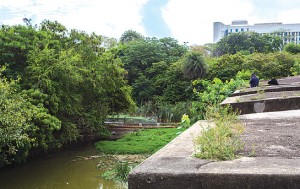Registered with the Registrar of Newspapers for India under R.N.I 53640/91
Vol. XXVI No. 08, August 1-15, 2016
A promise to clean the Fort’s moat
by The Editor
Last week saw a glimmer of hope as far as the conservation of Fort St George is concerned. Two of its many part owners, the Archaeological Survey of India (ASI) and the Army, have agreed that it is high time that the moat surrounding the fort is cleared of stagnant water (read untreated drainage from within). But before there is cheering all around let us hasten to add that the same announcement was made in October 2014. Nothing came of it. It is to be hoped that this year’s resolution will result in some concrete action.
 Fort St. George’s sewage filled moat. (Photo: Vijay Sriram.) See page 12 for what it once was.
Fort St. George’s sewage filled moat. (Photo: Vijay Sriram.) See page 12 for what it once was.
The moat is one of the many historic components of Fort St George that is rapidly going to seed. Originally a dry ditch, it later became a full-fledged moat in the 18th Century, with water from the Cooum River being let in to fill it.This was kept up till Independence when it was also common practice for the soldiers garrisoned in the Fort to fish in the waters. In later years, with hardly any water in the river, the supply was cut off and the parts of the moat fronting the fort went dry.
An added factor was that with seawater entering the river and the Buckingham Canal it was feared that brine would surround the fort and cause its historic structures to crumble. The two sluice gates that regulated water to the moat, one near the War Memorial and the other near Napier’s Bridge, were therefore closed permanently.
However, a new problem soon developed. Untreated sewage from the Fort began to be let into the rear portions of the moat and this has since stagnated. The water is mostly moss green and smells foul. It has also become a convenient receptacle for all kinds of rubbish from the Fort. And yet in spite of such neglect what is truly amazing is that the area surrounding the moat is full of lush vegetation and teems with a variety of bird life. The fact that this part of the Fort hardly sees any human footfall could also be a contributory factor. But it cannot be denied that the sewage has begun to post a threat to the ramparts.
 Can we bring the Fort St. George moat back to this enticing state? (Photo Courtesy: Vintage Vignettes.)
Can we bring the Fort St. George moat back to this enticing state? (Photo Courtesy: Vintage Vignettes.)
Recently, the ASI, the Army and the PWD agreed that it was high time that the moat was cleared of all its accumulated sewage. Work on sludge removal will soon begin and is most likely to be completed before the onset of the monsoon in October. The plan is, however, silent on how it proposes to prevent any further accumulation of sewage which the Fort will continue to generate. What is envisaged is that the entire moat will be maintained in a dry condition in its entirety, as the front parts have been for long. In a city that is perennially water-starved it would perhaps be deemed an unwarranted luxury if the moat were to be otherwise. However this may be the best time for the Government to rope in the Cooum River Restoration project into the activity and consider whether after the clean up of that water body there could be the possibility of the moat being filled with water. It must be pointed out here that most of the moats in India are now dry.
Whatever be the eventual condition of the moat – wet or dry, we at Madras Musings hope that it will be clean. We have written repeatedly on the moat’s sorry state and are now happy that some action is being contemplated. We also hope that the cleaning up of the moat will trigger off other restoration work within the Fort.

